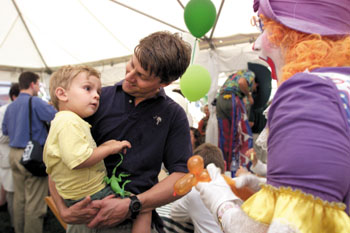
Dr. Moss Mann gets a balloon animal for his son Gus from Cotton Candy the Clown during the House Staff picnic during their orientation week. (photo by Anne Rayner)
House staff welcomed at picnic
The largest incoming house staff in VUMC history, a group of 205 physicians, began their residency training programs on July 2.
Most are newly graduated from medical schools, both nationally and internationally; a few have transferred from other residency programs. Of the new graduates, 28 have just completed their degrees at Vanderbilt’s medical school and have chosen to continue their training here; 15 are graduates of foreign medical schools.
The total number of house staff at VUMC stands at approximately 680. Their residencies range in length from three years – the minimum to qualify for a board examination – to eight years for certain specialties. Their basic responsibilities include evaluating and managing patients to assisting and performing surgical procedures.
Regardless of the time at VUMC, all residents have one thing in common, said Dr. Fred Kirchner, Jr., associate dean for Graduate Medical Education. “The ink may be dry on their medical school diplomas, but their education is far from over.”
To ease the transition from life as a student to that of a resident, the group recently attended a week-long orientation program sponsored by the Office of Graduate Medical Education. In addition to filling out paperwork for payroll and parking, health screening and computer training assignments, the residents attended a mid-week picnic.
During the orientation, residents also attended a number of seminars relating to their new status as house officers. Presentations covered a variety of topics including OSHA training, Medicare compliance, information management and risk management, as well as a history of the medical center and its culture.
In addition, each resident attended a departmental orientation for their specialty. Of the 18 primary specialty programs, those with the largest influx of new residents are internal medicine with 37 and general surgery with 30.
All in all, the orientation provided the much-needed information that will help new residents adjust to their new responsibilities, said Kirchner.
Kirchner’s office serves as a central support agency for residents, directing them to appropriate offices and people for information and assistance on a variety of issues. The extensive network of available resources aids in mitigating the stresses associated with the steep learning curve of the first year resident, and continues to bolster in the years beyond.













